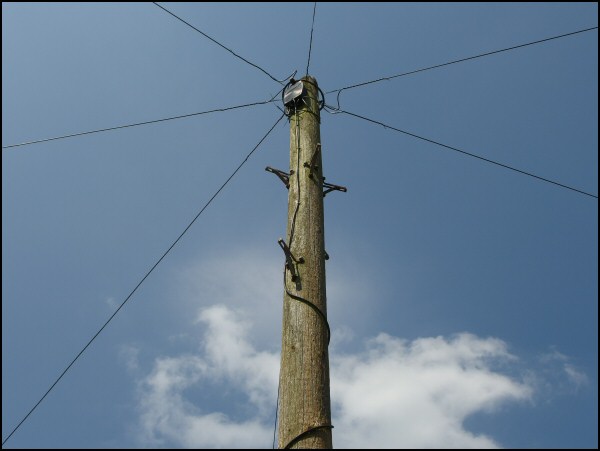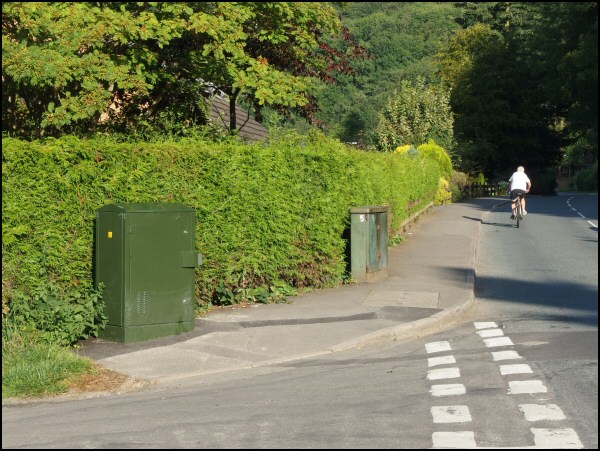This article was written for the September 2014 edition of the Stretton Focus, about fibre broadband in the SY6, Church Stretton, All Stretton, Little Stretton, area of Shropshire. See the footnotes for more, including a link to accompanying notes and resources. It is also available in a PDF version suitable for printing.
Super-fast fibre broadband comes to the Strettons
Observant Strettonians may have noticed that some new green roadside cabinets have appeared around the town this summer. These are part of the 'fibre broadband' infrastructure that is changing homes and workplaces across the UK.
What is fibre broadband?
Fibre-optic broadband, also known as 'fibre to the cabinet' (FTTC) or just 'fibre broadband', is a new way of providing internet connectivity for homes and businesses. It offers much faster data transfer rates than is possible with the ADSL system used by most premises at the moment.
Why is it fibre 'to the cabinet'?

Trying to squeeze 21st century speeds out of 19th century technology
Premises in the UK are linked to the local telephone exchange using a twisted pair of wires, usually arriving through an overhead cable. This technology is fundamentally unchanged since Alexander Graham Bell invented it in 1881. If you want a really fast digital transmission medium today, you use fibre-optic cables. These can carry enormous amounts of data at very high speed.
Replacing the wires to all 1000+ homes and businesses in SY6 would be impractical. So BT Openreach have run fibre-optic cables to Stretton's seven new roadside connection cabinets. Premises then connect to their nearby cabinet instead of to the exchange, and for this shorter distance the existing wires can deliver higher speeds.
What speeds can you get, and who needs broadband that fast?
The current ADSL2+ system gives speeds of up to 24Mbps download and 1Mbps upload, dependent on distance from the exchange. Speeds with fibre broadband are up to 76Mbps download and 19Mbps upload, dependent on distance from the cabinet. Most premises are much closer to a cabinet than to the exchange.
For the home user, these sorts of speeds open up new possibilities for things like high-definition online streamed video content that is stutter-free and with pictures as good as satellite or terrestrial HD TV.
For business users, it means that Stretton is as well-connected digitally as many major UK towns. For digital content creators, for example, the greatly increased upload speeds are particularly important. The author is one of those to benefit, and now uploads video files in 25 minutes that would previously have taken 8 hours to send.
How do I get fibre broadband?

New fibre cabinet (left) next to old cabinet at World's End, Ludlow Road
Most but not all premises in the Strettons can get fibre broadband now. The availability checker (see link at end of this article) shows whether a particular number can get fibre broadband, and what sorts of speeds that line can support.
Choice of Internet Service Provider (ISP) is important. BT have a monopoly on wires and cabinets, but there is a choice of ISPs. A poor ISP can mean poor speeds even if you have a great fibre connection.
Having chosen your ISP carefully, they will then steer you though the process of changing to fibre broadband. An engineer will visit and change the faceplate of your telephone master socket at your premises, and provide a super-fast fibre broadband modem. You also have to configure your router appropriately; your ISP can advise on this.
There may be a connection charge of �20-�50, or if you sign up for 12 months or more many providers will connect you for free. Monthly charges for fibre broadband vary depending on provider and package, but are typically about 10% more than regular broadband. Your existing router may be suitable, but if you need to buy another one, prices start from about �30 or it may be included in your deal.
Church Stretton � a great place to live and work
Fibre broadband in the Strettons has been made possible as part of Connecting Shropshire's �16m digital connectivity plan. The justification for using public money in this way is the long-term economic benefit that it will bring to the area. South Shropshire has always been a great place to live; now it is a great place for the new generation of digital gurus and online content creators to work, too.
Article by Steve Aze, summer 2014. This article first appeared in the Stretton Focus, September edition.
Steve describes himself as a 'creative geek' and runs a national educational software business employing 8 people. He lives and works in Church Stretton.
For links to further information relating to fibre broadband in the SY6 area, see www.aze.org.uk/FTTC